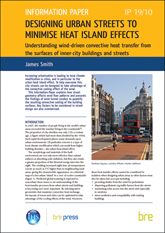
Designing urban streets to minimise heat island effects: Understanding wind-driven convective heat transfer from the surfaces of inner-city buildings and streets Downloadable version
Inner-city buildings and streets are creating a hot urban 'island' in a 'sea' of cooler countryside. Increasing urbanisation is leading to local climate modification in cities, and in particular to the urban heat island effect. To help overcome this, city streets can be designed to take advantage of the convective cooling effect of the wind. This Information Paper explains how street geometry affects wind flow patterns and presents the findings of wind tunnel studies to quantify the resulting convective cooling of the building surfaces. Key factors to be considered in street design are summarised.
Illustrations: 12 line drawings, 9 colour photos
Pages: 12
Introduction
Typical street geometries
Selecting the optimum street geometry
Wind tunnel studies
Effect of canyon width on the rate of convective heat transfer
Effect of wind direction on the rate of convective heat exchange
Conclusions
Acknowledgements
References
